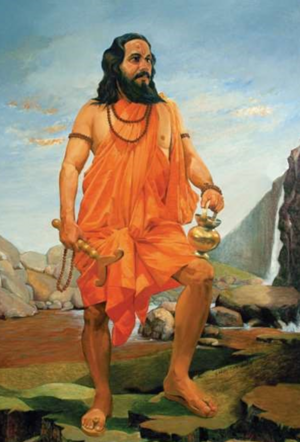Talk:Outdoor Sports:Gymnasiums, Gymnastics and Acrobatics
By Vishal Agarwal and The Hindu Society of Minnesota
Ancient texts talk about gymnasiums for wrestling and body building. A very noted example is that of 4000 gyms established by Swāmī Samartha Rāmadāsa, inspired by the hero Hanumān in the Rāmāyaṇa.
Hanumān Bhakta Swāmī Samartha Rāmadāsa, the Guru of Mahārāja Śivājī
In the sixteenth century, there lived a Saint named Swāmī Samartha Rāmadāsa. He was a great Bhakta of Hanumān. One day, as a child, when he heard how Hanumān had jumped across the ocean, he became very excited. He went to the shore of the river close to his home. Then he shouted, ‘‘Jai Hanumān!’’ and tried to jump across the river. But he was just a child. Instead of landing on the other side of the river, he bumped his head on a rock. He got a big bump on his forehead, which remained all his life.
But Samartha Rāmadāsa never gave up his Bhakti towards Hanumān. He set up hundreds of centers in western India to train in martial arts. Some say that the number of these gyms was around 4000. He asked youngsters to exercise, eat well, and have a disciplined life so that they too could become strong like Hanumān. Some of the exercise gymnasiums founded by Swāmī Samartha Rāmadāsa exist even today.
One of the Swāmī’s students was Chhatrapati Śivājī Mahārāj. With the help of Samartha Rāmadāsa, Śivājī was able to raise an army of strong and fit warriors. This army fought the evil Mughal Emperor Aurangzeb, who had caused a lot of problems for the pople of India. Aurangzeb used to order the destruction of temples, burning of śāstras texts, and even forced Hindus to either convert to Islam or die. The people were very upset, but they needed a leader to help them fight Aurangzeb. King Śivājī snatched a part of the Mughal Empire from Aurangzeb. In less than 100 years, the Hindus led by Śivājī’s successors defeated the Mughals at many places. Not just Hindus but people across all religions could again practice their religions and celebrate their culture with more freedom.

